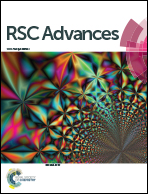Surface property and enhanced oil recovery study of foam aqueous dispersions comprised of surfactants–organic acids–nanoparticles
Abstract
In an attempt to prepare a foam system with a high surface dilatational modulus in high salinity water, we describe the surface dilatational properties and enhanced oil recovery effect of aqueous dispersions containing lauryl amide sulfobetaine (LHSB), organic acids and alumina particles (Al2O3). Phase behavior tests show that with the addition of a short organic acid, an aqueous dispersion composed of LHSB, organic acid and Al2O3 is stable and clear for more than 30 days in high salinity water (above 200 000 mg L−1). Surface dilatational property results show that with the increase of organic acid chain length, surface dilatational modulus increases. Besides, an interesting phenomenon is found. Shift time reduces with the decrease of surface area deformation, which is very different from conventional surfactants. As to the reason, the adsorbed organic acid molecules' response to surface tension gradient is responsible for the decrease in the shift time. Foam flow tests in porous media show that, similar to sheared foam, a finer foam can be generated from capillary induced breakup. However, owing to the different flow patterns from sheared foam, breakup only leads to a narrower distribution of foam size and can't induce breakup of the minimum bubble size. Finally, the aqueous dispersion of LHSB, lauric acid and Al2O3 showed a good effect on enhanced oil recovery in slug injection, which shed light on the application of enhanced oil recovery in high salinity reservoirs.


 Please wait while we load your content...
Please wait while we load your content...